-
Posts
5,779 -
Joined
-
Last visited
Content Type
Profiles
Forums
Articles
Gallery
Downloads
Events
Posts posted by jlpservicesinc
-
-
39 minutes ago, gote said:
I am afraid that the Ah Ha moment only goes further away.
I apologize if I misunderstand but you wrote: “with the bolt acting as a way to keep load on one side of the bosses while not loaded”. And “The pressure on the side forces of the taper force the jaw mount to one side. This puts force onto one side of the cheek plate keeping the jaws in alignment at the top. Side pressure against only one cheek plate”.
I understand this as that you mean that the bolt pushes the jaw against one of the plates because it is tapered. I cannot measure your vises but I measured on the pic. of one of them and find that the side plates deviate by 3.4% from vertical. Since the picture is taken from above it is probably less.
The situation when lateral play in the moving jaw is a nuisance is when one is gripping a round object and puts in a twist such as when tapping a hole axially in a round rod.
I understand you as that you mean that the taper in the bolt makes the jaw slide to the side.
If something is going to slide to the side, the slope must be more than the coefficient of friction and that is several times higher than 3.4%. (already the pyramide builders knew this) Even if friction were zero, the side force is only about 3.4% of the lateral force, which hardly is enough to stabilize the jaw in the tapping operation referred to above.
The other possible way that the bolt can move the jaw, is that it pulls by engaging in the taper of the hole in the jaw and with a slope of 3.4% it will certainly jam. The Morse cone is a middle way between jamming too much and jamming too little. 3,4% is less than the Morse and will jam very efficiently.
Thus I very much doubt that a tapered bolt can stabilize the jaw by pushing it against one of the side plates.
Does the taper in the plates take up the forces from above if the bolt pulls them together?
Assume we have a force from above of 100 pounds. There is friction between the jaw and the plates. Say 90 pounds are taken up by friction. 10 pounds left. These ten pounds exert a side pressure on the plates of 10/0.034=294 pounds. Assume the cross section of the bolt is 1 square inch. Thus the tensile stress in the bolt is 294 PSI. Now assume pure shear in the bolt. There are two shear planes thus we get 50 pounds per plane and that gives us 50 PSI. The tensile stress in the taper-jaw-situation is thus nearly six times the shear stress in the pure- shear-situation.
Have I assumed too little friction? I do not think so. The coefficient of friction is 90/294=0.3 definitely not too low. If we assume 0.2 instead, the tensile stress will be 9 times higher. Have I forgotten the stiffness in the plates? No since the bolt has been pulled tight the plates do not relieve the bolt. They increase the tensile stress.
My conclusion is: Yes the taper will transfer force to the plates but that does not put less strain on the bolt. It only changes from shear to a much higher tension AND it is mostly by friction. The friction will only develop if the jaw sinks a little so it wedges. Thus there must be sufficient radial play in the bolt. Otherwise it is a question of shear anyway. If the bolt is pulling the plates so tight that the wedge-support situation develops without this radial play in the bolt, the spring will be unable to open the vise.
The shear situation causes a stress concentration. How important this is, depends upon how soft the pieces are and how close the contact areas are.
Is shimming a bad idea? No. In my vise, the plates are much higher than vide. The distance from the bolt to the leg is much less than the distance from the bolt to the upper and lower edge of the plates. The bolt pinches in the wrong place. The edges of the plate will move less than the centre. This differs very much from the pics you show of rusty vises. In those cases you may be right.
Tolerances: With a 3,4% taper, the tolerances are about the H/h8 magnitude and that can be achieved with a suitable reamer (100$ if I can find on with the correct taper) and a good lathe (and someone who knows how to do it). With my taper of 0.5% it will cost a fortune to have it done.
RiffRaff = People regarded as disreputable or worthless. (Check your dictionary)

You are saying the basic same information.. Only one clarification.. The tapered bolt only holds the the jaws in alignment by keeping pressure of the bottom boss/pivot in contact with the cheek when there is no load and the jaws are nearly shut..
the bolt only holds the jaws straight while in the nearly closed position to about 1.5 -2" out..(nothing said about a load or force) After that it's the taper of the cheek plates that holds the jaws straight.. If you want to talk about loads take a vise as in the pictures and it will make sense.. Tighten the nut as you move the jaws you will see the results.. Rust has nothing to do with it..
I high lighted your example above..
You are also talking about Torquing forces verses hammer forces or linear forces.. 2 total different forces and this I was not referring to at all nor mentioned..
A blacksmith leg vise will always have twist in it if you are threading a round rod.. it is deforming to offset the forces you are putting into it, It's not really designed for the greatest jaw stiffness in a torsional use environment.. It's designed to be pounded on and the reason all the pieces are designed the way they are..
Those same torsion forces come into play when holding anything off center of the jaws..in a small vise you can see the amount of torque being applied as the off side jaw moveds towards the stable jaw very easily.. Larger vises have less deviation because of the larger mass..
a Torsion rod in a car twists to create a load at either end of it's attachment points an this is supposed to help recenter the car body mass.. so it bends then once the car is level again.. so is the rod..
A leg vise has very long members in relation to jaw and then screw distances and then pivot.. that 2FT of torsion rod.. You will get twisting in the front jaw no matter what you do.. it's like a torsion rod in a cars suspension..
You can tighten the joint all you want and it will still torque.. It's how it's designed..
The only way you can get little or no torque movement is a very short jaw profile with very short pivot like in a machinist vise..

Your looking at this from a very different perspective.. What you see is a different picture of what I'm showing because of perspective.. I'm showing how the vise jaws stay in alignment with forces being applied in hammering which are downward or backwards (towards the rear jaw) for the most part..
What I took away is : You are looking at twisting motion.. Ain't no way you are going to get them to stay straight to much torque load out at the very end of a long member..
You'd have to redesign the whole thing if you want to overcome torque loads..
Buy a very high quality machinist vise and you will be all set... . Apples, oranges.. Pineapples.. No wonder why it doesn't make any sense.. Your looking at how to stabilize the jaws against torque instead of straight downward force..

So, because you are looking at this all torquey.. It is the exact opposite.. because the bottom boss and the cheeks are a taper.. As you twist the rod in the jaws the vise front jaw will want to torque as its' not only over coming your twisting forces but also now you have a wedged cam going on at the bottom. . Basically your are wedging the jaw at the boss and this will actually cause a loosening of the area and the bolt will have little effect other than holding the cheeks together and keeping the jaw from rising..
In this situation a straight sided wall would be best, (not wedging) but then you would end up with all the load when hamming on the vise going into the bolt unless you had a german vise where this load is shed partially by the cheeks and the guides bosses on the jaw...
Just put a wood wedge in a vise and tighten it slowly.. the wedge will raise.. or put it in a vise and just twist it with your hand.. it will raise as well... or a cold hardie. Even a better example..
If the twisting of the jaws is really what your looking at eliminating they a high quality machinist vise will solve your problem..
Most old time shops had a leg vise and a machinist vise for the exact reason you are talking about...
Even the big 8" Columbian vise which weighs 230lbs and the moving jaws leg 2.5"X 1.5" twists when I'm threading 3/4" rods.
If a free world, with free thought.. You can do all you want to.. I'm merely showing how these things were made.. If shimming works for you.. Go for it.
Personally I go and fix what is wrong and then I also account for the limitations of the equipment I am using and adjust to get the desired results.. I tap and thread rods in the foot vise all the time and find the twisting of little consequence other than having to realize there are other counter forces at play..
If it's the tapered bolt, don't use one.. there is a reason this stuff works.. I'm not the designer or the engineer.. I'm just a user who shared what they know..
In the end you can do what ever you would like.. It's all good.. Right or wrong makes no difference as it's all perspectives which change with time...
-
That's awesome.. nice find..
How much?
-
1 hour ago, gote said:
I really appreciate the effort you are putting in. The pic is very helpful.
A tapered jaw will obviously take up some of the downward force and transmit to the side but how much? I do not have the time to calculate today but I doubt that it is very much. In the German pattern I have, the jaw rests directly on the top of the plates (which are rounded) so the bolt is unloaded from above. Unfortunately the bearing surfaces are worn so the bolt now takes the force. I will have to open the hole in the jaw upwards.
You draw with a play under the head and this of course solves my question regarding the head. However:
If the play would be 0 to 1 mm and the taper - as in my case - is 0.5%, the combined tolerance on the pin diameter and the hole is 0.005mm = 5 microns. Somehow this feels difficult to achieve in a blacksmith's vise. Even with the larger tapers shown in the photos, the tolerances will be very narrow.
Further if the taper of the pin/bolt pushes the jaw against one plate it will jam in the jaw. Compare a morse cone that has a much steeper taper. Thus it will turn with the jaw which will defeat the key you are showing on the head. My own pin/bolt does not turn with the jaw but sits fixed. That is a good thing, since I consider a bolt that turns that way to be a design error. The nut will quickly get loose unless it is locked positively by peening, split pin or similar method.
If the nut is locked against the plate, a turning bolt will tighten when the vise is opened (Assuming nut to the right and right hand thread). Nut on the left hand will open the jaw and counteract the wedging you talk about.
What prevents lateral movement of the jaw is the top and bottom of the plates but the bolt sits in the middle. The plates do not necessarily move as flats when pinched in the midde. The corners may move less. I still think shimming is more effective and my test confirms that this works.
Look at the picture again.. The notch in the bolt head and the same cutout in the cheek keeps the bolt from turning.. Look at the pictures I posted earlier.of the newly made bolt. It shows these notches clearly..
I think in some way you guys over think this stuff..
The drawing it shows that the bolt to the vise jaw is "almost" a tapered press fit.. I didn't say it "IS" a tapered press fit (and pull the bolt in till it binds) that would bind like a "Morse taper" by the way a morse taper "Will Not Hold" very well or bind (which is how it really works) if there is ample oil, dirt or grease in the socket with no inward pressure.. Remember for a morse taper to hold properly it has to be clean or lightly oiled and then "Forced in" till the two sides (faces of the female and male socket) have pressure evenly placed (IE Jammed together).. This pressure inside the so called "almost tapered press fit" is controlled by how tight the nut is on the outside and hopefully you grease or at least oil the joints upon assembly.
The bolt is not to support the jaw, the cheeks are to support the jaws,, The bolt is to add cheek pressure and it keep them from spreading as well as acting as the pivot for the jaw and keeping it located in the cheeks (pivot).
It is a combination of all things.. Tapered cheeks, tapered jaw boss, tapered bolt.. . This makes the vise nearly indestructible and why they last so long.. without the tapered cheeks the bolt becomes the main weight bearing. It will fail in short order as the bolt is in a shear plane all the time.. (They did make the cheaper ones that way).
German vises use the cheek plates as part of the weight bearing and supporting structure but in a somewhat different manner.. If your cheek plates are damaged or the receiver bosses in the jaw for the cheek plates are damaged.. Then the first culprit to make it straight will be the bolt most likely deformed.. means there is deformation at the bolt, the vise jaw boss and the cheeks or a combination of all 3..
The only fix for this is to make everything like it was brand new with the proper clearances.. Adding shims is not how this is fixed.. Fixing it the right way with adding materials (IE welding) or putting back the materials (peening back) that have been distorted, checking to make sure the bolt is not deformed, making sure the clearance in the vise boss is not egged out.. ETC, ETC..
For clearance you can make what every you want or find what works.. Your going to make the thing right... Just forge it out and then see what works..
(In regards to your question about bolt clearance under the head)
for the clearance around the side cheek with the bolt head on it.. The shaft under the head can be the same taper as the rest of it with no clearance at all.. Problem is if you tell someone this who has never made one they make the head exactly at the cheek and this eliminates the ability for further adjustment in the future. and will actually make it so the contact area between the bolt and the jaw boss will be to small (it will be Sloppy).
Then they come back and say I don't know what I'm talking about.. Because it didn't work for them and they spent all the time when they could have just drilled the hole out and put a regular bolt in..
So after a new bolt is made.. make it exactly to the tapered fit.. Just leave some clearance under the head.. Is that more helpful..
then I say figure it out on your own. The information is there. "It's correct for this type of vise pivot".. I've seen hundreds of examples and this design is the most robust.. I've also seen straight jaw bosses, straight bolts. I've seen lots with stripped threads because the jaws didn't align and the person just over tightened the bolt and as soon at they open the jaws which are now very tight at the 0-1" mark can barely be opened the rest of the way and they force it and the threads sheared off the bolt so no nut..
Give it some more thought and though it may seem frustrating and that its not understandable when the "Ah Ha" moment comes it will be crystal clear..
Just because something is made by hand via a blacksmith does not mean it can not be accurate and made to an exact size.. By the way.. I'm not an artist blacksmith.. I'm a trades blacksmith..
So, the simplest answer is to just fix what you find to be wrong.. If your vise doesn't have a tapered bolt forget all about what I wrote.. It's that simple..
Oh one other thing.. Some of the vises don't have a hotch to hold the tapered bolt.. since the taper on both cheeks has great area vs the pivot it still gets held against the pressure of the pivot to turn the bolt..
-
2 hours ago, JHCC said:
If I understand jlpservicesinc correctly, you have to think of what happens when the vise is under load. When you tighten the screw, there is pressure at three points: where the jaws grip the workpiece, where the screw squeezes the jaws, and the pivot at the base of the movable. If there is any room for the pieces at these three points to move, they will, until they come to some limit on their range of motion. The limit at the jaws is the thickness of the workpiece; at the screw, its length. Now, when there is no load on the vise, the boss at the base of the jaw has a certain amount of sideways play, but when it goes under load, that load will force it to take the path of least resistance: towards the thin end of the tapered pin. It moves in this direction until it reaches the cheek plate and stops. Because there is this sideways force between the boss and the cheek plate, the jaws are forced into alignment, and the sideways play is eliminated.
Ok, so just to clarify: It's the vise cheeks and taper that keep the jaws in alignment when under pressure.. The bolt limits the spreading and this keeps the outside jaw from sinking lower when impact is made. This downward force acts like gravity and pushes the bottom jaw boss more sideways then down... The thru bolt is not receiving all the pressure.. This side load transfers some of the forces to the cheek..
Since the cheek plates and the boss on the jaw are tapered as the jaws open it wedges the jaws deeper at the front of the wedge.. This keeps the jaws in alignment as the jaws open past a certain point..
3 hours ago, gote said:I am learning something new all the time Thank you. It never occured to me that the plates would not be parallel but you are right I have a taper of about 0.5%. The difference in dimension is about the same as the play between the plates. I still have not time to disassemble the vise but I tried to push in temporary shims. That made the side play in the jaws disappear nearly completely. I still do not understand how the tapered pin can push the jaw against one side. Maybe I am using the wrong word. With pivot I mean the bolt that goes through the plate and is the hinge. It has a head on one side and a nut on the other. It cannot be forced further than the head. allows.
I would be possible to turn a pin with a step and let it push the jaw against the plate with different hole sizes in the plates but it is not something I would like to do.
The play is more than likely caused by either a worn bolt or a loose nut and worn bolt.. The cheek plates will flex some when tightened..
Think of a hill and a ball.. The ball will always roll down hill.. The tapered pin is the hill and the ball is the vise bottom boss.. The taper serves 2 functions: increases the contact area between the jaw lower boss (pivot) and the bolt vs a straight bolt and helps to shed the load sideways into the cheek when struck..
It also helps with shear loads since the sideway forces involved redirects the load..

I've attached a crude drawing but it should help explain some of it.. Them old workmen who made all this stuff really had it figured out.. More knowledge has been lost than has been gained in my mind.
Also while a lot of this information applies to blacksmithing foot vises as a whole there are variations for any given maker and/or where it was made.. German made vises and the older italian made vises are beautiful and beautifully made.. American's simplified and expedited everything..
By the way all the new commercially available vises have done away with the tapered bolt and bottom cheeks.. Costs more to MFG..
-
In the years since I really looked into this stuff.30 years ago, I have forgotten more than I remember at this point..
Coal smoke is a heavy smoke.. It is heavier than air.. It will sink vs rise if given a chance..
So, pressure differential can be a friend,(have a tight shop and having a fan in the window blowing air in will pressurize the buldiing and make the stack draw better), and then a hot pipe. (we all know a hot fire draws a lot better). I paint the stacks black so in the summer sun they get a little hotter from the sun then the cooler air at the ground.. this helps with Draught/draft.. A proper stack/hood design is the next phase..
My recent trailer build I was asked why a tall stack.. The higher the stack up to a given length the more consistent the draw and the higher the velocity of the slower air which is not smoke and such as the air at the ground is cooler and as it's heated while going over the forge will pick up some heat and this will help the cycle continue.. Also a longer stack will handle pressure differential pulses better..
The secret to a smoke free shop is to design a stack/forge hood to catch the smoke before it has a chance to expand.. Cooler air being drawn into the heavier coal smoke will make it want to settle back on itself and starts to expand as it cools rapidly and separates out of the heat stream. The stack is about 15ft long.. 12"X12"..
-
the lever blowers were an early adaption away from bellows.. It still retained the pump, pump, pump like the bellows people were familiar with but had the blower.. some of the pump models worked very well even better than some of the lower billed hand crank blower models.
Other nice thing is the pumping can be a lot easier on the shoulder if the lever is low enough..
-
2 hours ago, gote said:
I do not really understand this. Of course a tapered pivot in tapered holes can be pushed in so that there is zero play but how do you do that if there is a head on the pivot? It seems to me that it is no better than a non-tapered. I would have thought that the play between the plates would be the most important way to control the jaw. The distance from the center of rotation (sideways) is much larger. I have in the pipeline to shim my vise to decrease lateral movement. I do not trust my skill to be able to bend the plates the exact amount. I will also have to figure out how to lower the holes in the side plates since this is a German style vise where the moving jaw slides on circular surfaces on the fixed jaw and these surfaces no longer support as they should.
Not clear on what you mean by " I do not really understand this. Of course a tapered pivot in tapered holes can be pushed in so that there is zero play but how do you do that if there is a head on the pivot?".... What head on a pivot????
The bolt does not center the jaw.. The pressure on the side forces of the taper force the jaw mount to one side.. This puts force onto one side of the cheek plate keeping the jaws in alignment at the the top.. Side pressure against only one cheek plate..
The bottom portion of the vise jaw boss has a taper the same as the cheek plates.. Narrower at the bottom than the top.. The bolt that goes through both cheek plates and the vise jaw leg boss has the same taper with a tapered hole..
The tapered pin (threaded bolt that goes through) takes up the cheek plates to keep them fairly tight and from spreading..
A tapered cheek vise will not open past a certain distance between the jaws because of the wedging effect of the cheek plates.. If you loosen the bolt it will open more because you are forcing the wedge into the cheek plates spreading them..
-
50 minutes ago, BOB T said:
JIP... Good to let people know about WI ..Otherwise most ends up in the scrapyards as plain steel
There is a old bridge just setting out in a cow pasture ..it is WI , Has some nice bars that 1 1/2 " Sq 15' in length..I stop by every couple of years to see if the farmer wants to sell it ? The funny part is it not over a creek or ditch..just out in the grass. Maybe some day he will sell it ?? Would hate to see the WI go to the scrapyard .
Yes it is.. Lots of good information here on WI..
I regretfully gave away about a ton of it back when I quite smithing.. Was great quality.. Gave it to a blacksmith friend of mine who ended up with my 200lbs Myers..
If you have a chance to get the bridge.. It would be such a sweet deal.. Most that stuff goes to Scrap here without ever having a chance to grab any as the state projects frown on any civilian approaching a work site..
-
BobT, This thread probably turned into a whole different beast than expected?..
Here are some pictures of the wrought iron I stumbled across while out walking.. As mentioned before I believe they were used for rigging for cranes that worked on the Railroad as well as a watershed project by the state..
One other thing about wrought iron.. Overall it's not as strong as mild steel.. Tensions it's only ok. compression is pretty good. But any notch test and it will usually fail..
I had to cut a 3/4" bar to be able to straighten a section and with only an 1/8" notch I could easily break it in 2..
I was going to show some little videos on the difference between forging hot short and cold short as I had a piece that hated being worked hot so much so I think the guys who made it were happy to see it leave the shop.. It was originally used for a loading dock bumper.. Anyhow, after I was done with the majority of trailer making I had a scrapper helping me clean things up and the section (about 2ft long) must have gone with him.. Oh, well..
anyhow heres some pictures of the iron i found and the notch I cut in with the open break..
-
Slooks good to me.. besides ghat if anybody gives you any guff that B.O. would make a formidable weapon..:)
A friend of mine came over for knife making day I was 15 and he was 14.. We made knives out of what ever was hanging around.. He ended up picking a bar of some low-medium carbon 1030. about 20" long.. He forged a blade on the end of it about 6" long.. I said it will never work, or hold and edge (low carbon) and since he burnt it would break in use..
That knife he made was such and excellent chopper.. only about 1/8" thick at the spine. the blade held a great edge, it never cracked or bent.. I used to water harden everything. Anyhow, the only explanation I could come up with is " Him burning the metal gave it just the right brittleness so as to offer all the attributes the blade had.. Maybe a 1 in a million shot, whos to say..
-
9 minutes ago, Michael Cochran said:
You people make me so jealous. I have yet to find any real wrought iron. Every time I think I did it turns out to be some kind of modern steel. I have a small piece someone gave me but don't want to use it for anything and end up loving it so much I 'have' to find more. I'm still holding out hope I'll find some one day.
go over to where there are any old mills and just look around.. or old farm silo's.. Before the chinese bought up all the scrap a few years ago you could find it just about everywhere.. Now it's slim pickens but still find a piece here or there if you look..
go over to abandoned farms.. In the olden days people would just stack the scrap up..
Today on my way home from feet duty.. I stopped by an old mill site which burnt and grabbed a few ends just laying in the dirt..
There were some 1"round rods about 12ft long but they were stuck in pipe filled with clay in a brick foundation and the nuts were still on the ends.. Can't make off with those on the down low..
I did just find 4) 3/4" rounds 20ft long that were used on the rail road for stabilizing crane rigging.. These had the stamped in numbers of the smith who made them.. Pretty awesome.. The forge welds were perfect.. I'll post pictures up tomorrow.. Also found some vintage rebar.. They were all just stacked up like someone forgot about them.. I had to dig them out from under trees and roots and about 6-12" of new soil/hummus..
-
36 minutes ago, George Geist said:
What did you use for the clinch cutters? Leaf spring? I've used old rasps for them but really hate using old rasps for most stuff.
Yes old leaf springs.. the short one I made on my own and the long one I had a striker. Took like 15min with his help in the sledge.
-
4 minutes ago, George Geist said:
Neither, just wood. Pine I think
huh. From the picture looked like horn to me..
-
28 minutes ago, George Geist said:
Nice work

Here's my knife:
http://horseshoersforum.invisionzone.com/index.php?/gallery/album/1-hoof-knife/
Wish I'd have taken more pictures of more things.
George
That is sweet.. Antelope handle? or deer
-
Ah, are these blacksmithing jobs or any jobs? If I take out the time machine and go back 20years I'd say I'd do nothing different but understand people are people and they don't understand what it really takes to make something with your hands and have it come out looking so sweet you don't want to part with it, let alone sell it.
If you make something look easy.. People assume it is easy and they aren't willing to pay you a premium for you expertise.. If you make it look difficult and can promote your expertise (though the work is not very good or is good) you will end up far better off..
I knew a guy who did very shoddy forge work, mig welded everything together and charged big money and was so busy it turned into a big success and retired with money in the bank..
I've learned over the years.. It's the self promoters, and networkers that do the best even if their work isn't as good as somebody else.. Some how they convince the people that the work is better though I wouldn't put it in my outhouse..
It's the human connections that get, keep and sell business.. People like the down trodden, the underdog as they can sympathize with them,. People have a hard time with talented people which either envy or fear keeps them from connecting with..
Or you have to make a product no one can find anywhere else.. But first and foremost its the human connections..
I took 12 years off from being a professional smith because of not one particular job but many particular jobs.. I was robbed of vision through my own misunderstandings..
Some people have it some don't.. I know where I stand..

-
1 hour ago, SReynolds said:
Though not
entirely
on the subject......this has everything to do w/testing your bar stock; The Blacksmith Community Forum on Facebook says no. That Rebar is clearly marked exactly what it is in terms of alloy agent(s) and carbon point. There is no guessing. This is the first I have heard about rebar stampings as all folks I know say you don't know.......so....I'm at a loss. I have no rebar. I have used it and found it welds poorly, but that was my very limited experience. The community forum says rebar makes good tooling, if you acquire the quality stuff. Apparently there is high carbon rebar and because it is so very inexpensive, this is what folks desire, so look out. There may be a truck in your neighborhood collecting high carbon rebar. Probably late at night..........(?)
Thanks for the explanation of wrought.
I hate to highjack threads.. I try to stay on point but there is just so much information.. the post I made earlier on Wrought iron and why it's a great material was posted from my car in-between jobs..
Rebar comes in all sorts of classifications.. There is high, medium and low carbon rebar.. One also has to remember what rebar does.. in layman speak "concrete cannot sustain elongation loads or tension.. only compression".. Rebar makes it so tension and elongation can be handled by the concrete If you find a good sample and can get some then go for it, I've made decent quality swords from it with differential heat treat.. Show nice hardening line with polishing..
Certain rebars can be tough to weld..
Anyhow, the rebar depends a lot on where it came from as well as when it was produced. there is some real garbage out there. but also some really nice stuff.. I found some rebar from way back that was carbonized wrought iron.. It was priceless for any knives or wood working tools..
Same can be said about rail road spikes.. depending on where they came from (high speed rails, heavy hauling rails) will dictate which kind of spikes they use..
Basically if the material is unknown to the user and does not have a spec sheet (even with spec sheet one should verify their heat treat methods to achieve the best results) with it then it should be tested as any good smith worth his or her salt should do automatically before they make something out of it.. Did I say I was old school..
Your welcome..
3 hours ago, Charles R. Stevens said:JLP, now we have rebar and A36, lol. We are back to testing the mystery metal, lol
I love mystery metal..
 just made a new hoof knife out of a lawn mower blade.. Wouldn't harden in oil.. LOL>> Water hardened only.. only took 3 times to figure it out.
just made a new hoof knife out of a lawn mower blade.. Wouldn't harden in oil.. LOL>> Water hardened only.. only took 3 times to figure it out.
-
Sorry I never answered your question. .
It forges like butter 2-4× faster than 1018. It's extremely easy to forge weld (when not hot short), it's highly rust resistant.
BUT , it won't put up with being forged badly.. proper forging techniques are a must.
-
1 hour ago, SReynolds said:
I'm not following the "real delight and joy to work with" comment. If you have to bend it, then test forge it both hot and cold to ID it, what advantage is that over buying say, 1018? I mean you know what 1018 is. There is no test procedure involved. Just heat it and work it.
I have tried a little wrought given to me. It comes apart as I forge it. I understand now I'd have to "test it" as some must be worked hot and some worked a bit cooler?
I don't ever remember having to test 1018 thus that would seem to be a pure joy in working it.
I don't want to come off sounding tright or snippy.. but it's and educational learning lesson..
Today Pretty Much EVERYTHING Is a known entenduty. (1018 has specs within a certain range no matter where it's made)
Back in the olden days you would get rough formed bars from the iron monger and then the smith would forge them to the required size. That was the real reason for swage blocks and the reason the holes are tapered..
Real wrought iron has characteristics all its own and it cannot be forged incorrectly where 1018 or 1020 it can be made a mockery of forging wise and not spit back at the smith..
Wrought iron was phased out for many reasons but the main reason is it can't be forged or shaped like modern steels.
Towards the phasing out time the wrought iron produced was of the highest quality straight from the furnace and was on par with mild steels of the day, but then the amount of labor was excessive and to costly so by,by..
Anyhow, smithing today has been dumbed down in a few ways and made easier to partake in..
For starters you don't have to analyze through working or hardening any of the steels since you know what they are. This experimenting of each bar gives you a intimate knowledge of the properties of that bar , which forging methods are needed, which heat treatment for each bar etc etc.. Which you would have to figure out on your own..
While from today's standards it would seem like a waste of time all that testing makes you a better smith because you learn by what works and what doesn't via feedback of the material vs just being told..
Basically it's one of the abilities that gave blacksmiths as much lore as they had gotten and also why some smith's were famous for problem solving verses others..
Without real wrought iron the really fancy very intricate works would have never been made or have lasted as long..
-
8 minutes ago, Lou L said:
WHEW! You had me both worried that I had learned everything wrong and excited I might learn something new.
But here's my secret:. Even if you gave me a list of ten good reasons the steel I used was bad for the purpose I would have used it until I proved all ten of them right or wrong. I find that pain, suffering and conflict is the best teacher. That's how I'm learning to make the tongs I need rather than using the wrong ones.
You sound like we have lots in common.. I'm self taught and stubborn as a mountain..
When people ask me how I learned my trade, I respond I'm self taught, . they say good for you and then it must be really retained as I had to make the mistakes to learn the correct way.. . What it proves is I'm just not afraid of hard work..
With age has come a little more wisdom.. It's always easier to learn from others than from yourself and the learning curve is much faster with much better results..
I to always question and it used to make many mad..
So, if you can learn something like proper forging technique or proper coal fire management or making tongs, etc, etc from someone it will free you up to learn other things and put you that much further ahead learning it from someone else..
Sorry if it seems like a lecture.. Been there done that and I won the teddy bear many, many times.. Would have been much easier learning from someone else..
-
26 minutes ago, TwistedCustoms said:
Your driving hammers make me smile. As a Farrier who uses these tools for their intended purpose, is it upsetting to know that I use an old Diamond brand clinch cutter as a hot cut for small stock? I also have an old pair of clinchers I straightened the curved jaw on to hold 1/4" stock. They are very "toothy" tongs but they do grip!
Thanks, Upsetting.. No not at all.. It they work for you thats all that counts... Now if you said you did it to a rare tool then I might be remiss a little..
22 minutes ago, Frank Turley said:Good work. Having shod horses for a time, I can appreciate the tools. The adjustable bar on the testers is nice.
Thanks.. As you know.. Good tools certainly help make a good job but also good tools make a job easier..

-
Well since i mentioned it in another post and someone said I should post up pictures..
Here are some pictures of the tools used in the Farrier trade I've made over the years.. One thing about the farrier trade is unless you abuse your tools they will last a very long time.. The hoof knife gets the most abuse and gets constantly sharpened.. Like 5-8 times a day or each or every other stop or if its dull. so depends on how much dirt is packed in the foot and how dry the foot is.. Hoof knives still last 6months to a year..
First are clinch cutters.. short one made in 96, long one 07. Then 2 different driving hammers. smaller one 89, larger one 90.. Then adjustable hoof testers. 1990.
Then a few hoof knives of different designs.. And then a picture of how it is used..
-
Wrought iron and quality can not be lumped into one heading.. Wrought iron in the hay day varied from batch to batch and some were cold short and some were hot short.. Cold short didn't like to be worked cold and hot short didn't like to be worked to hot.. I've worked with both types and have found that it is inconsistent with the quality that either has.. One rim maybe hot short the other cold short..
Where quality of wrought iron comes in is actually both of the hot/cold variety but also how many times it was heated and forged to get to the desired thickness..
The more it was heated and forged to size the tighter the grain structure and the better the material as most the impurities have been worked out of it. "This translates into higher quality"
The highest quality anvils were made from scrap because it offered a better forged wrought iron than freshly made wrought iron ..
If the tires have wear on them you will be able to see the grain structure and the level of unevenness in the face of it..
To test the wrought iron for both hot and cold and quality work, do a bend test.. it's it really low quality it won't like to bend without fracturing.. and work it at a white heat and again at a red heat.. do it at the end of the bar forging it down to say a square and as you work it it will start to unravel either at the hot or cold heat.. Kind of neat..
One other thing.. Wrought iron.. Real wrought iron is a pure delight and joy to work with.. Everything just forges that much better..
-
1 hour ago, Lou L said:
Thanks JLP, I'd like to think that, while I haven't acquired all the skills I need to really call myself a blacksmith, I just might have the mentality down! I'm completely experimenting it's these bolts. They are a medium carbon alloy steel designed for toughness...loads of tensile and shear strength after heat treat. I opted to not heat treat my cut off yet just to see how the metal handles the abuse..(also to save my hammers from my forthcoming mistakes).
I'm curious to know why alloy steels are less desireable. In this particular case I'm not bothered it it has a low useable life because, either way, I'm quite certain that I'll be making another one!
I love alloy steels and highly desireable..
For some reason there was a few sentences that were completely missing from what I had wrote.. for some reason my posts here have been cutting off pictures and now sentences.. ???????
I was referring to cutting alloy steels on your unhardened or mild steel hardies.. Alloy steels can have a very hard grain structure even at red heats unlike mild steels and the reason I wrote:
You can even use mild steel for hot cutoff hardies as long as the cut isn't to deep or used on alloy steels.. If the mild steel hardie proves to be to soft for your hot cut hardie then you can try cold forging it to work harden the edge, or case harden it.. Cheap and easier to make and when your working with larger materials medium or high carbon steels are much more finicky..
mild steel hardies can work well on smaller stock up to about 1/2" as long as your cutting heats are high enough and your fast at your cuts.. . I probably made 6 or 7 mild steel hardies over the years when I was first learning as well as punches, and drifts and a hot chisels a time or 2 for something i was only going to use once.. just have to understand the limitations a tool made from low carbon steel offers..
-
9 hours ago, Lou L said:
If it cracks I will learn how foolish I was and then I'll make another!
If you look at it once you'll notice that I didn't even bother making the shoulders of the cutting end even. I didn't think it mattered. The cutting edge itself is straight and true and it fits tightly into my hardy hole. If it works well and seems to last maybe I'll make a pretty one out of another bolt. Honestly, I'm waiting for some one to tell me those bolts are no good for hot cuts. I haven't found anyone using them for tooling and figure I'm missing out on some basic information.
Lou L. I absolutely love the fact you expressed if it doesn't work you'll just make another one..
thats how we get better with all this forging stuff.. it doesn't work.. Oh, well.. I'll just make another one..
I've made some unique tools over the years and thats always the thought I have.. if it doesn't work, it was a learning experience..
For hot cuts as long as they are not to deep and not on alloy steels they can work for sometime before the edges upset and create problems.. then if it does become a problem you can cold forge it to give it a little more hardness or surface harden it..
Or just make a new one..


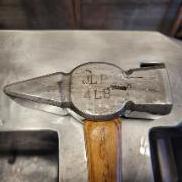
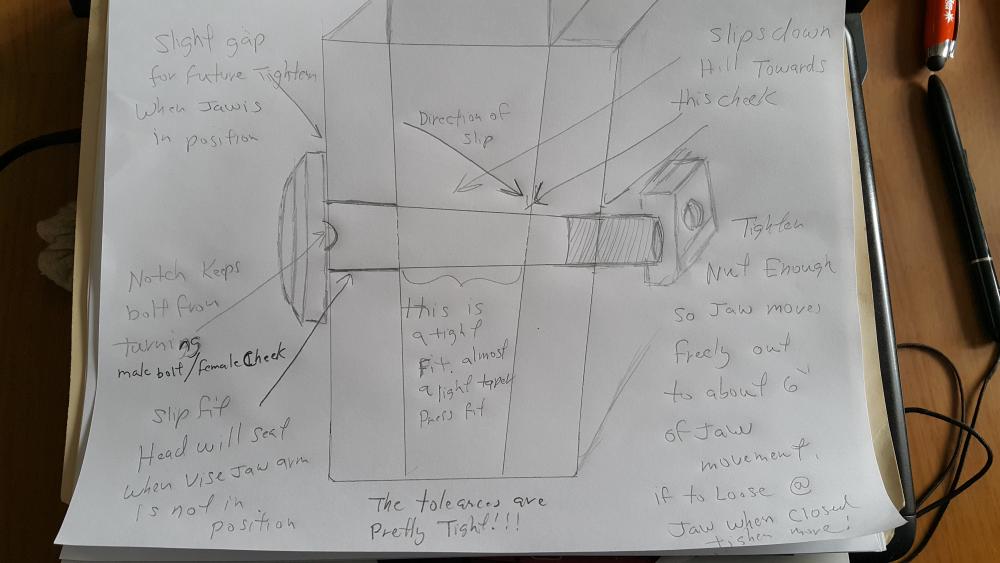
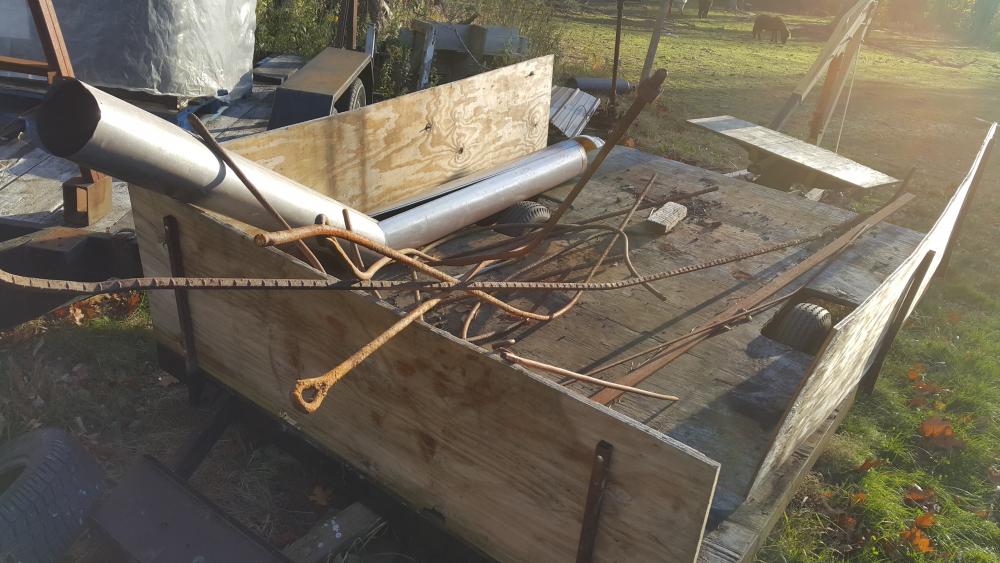
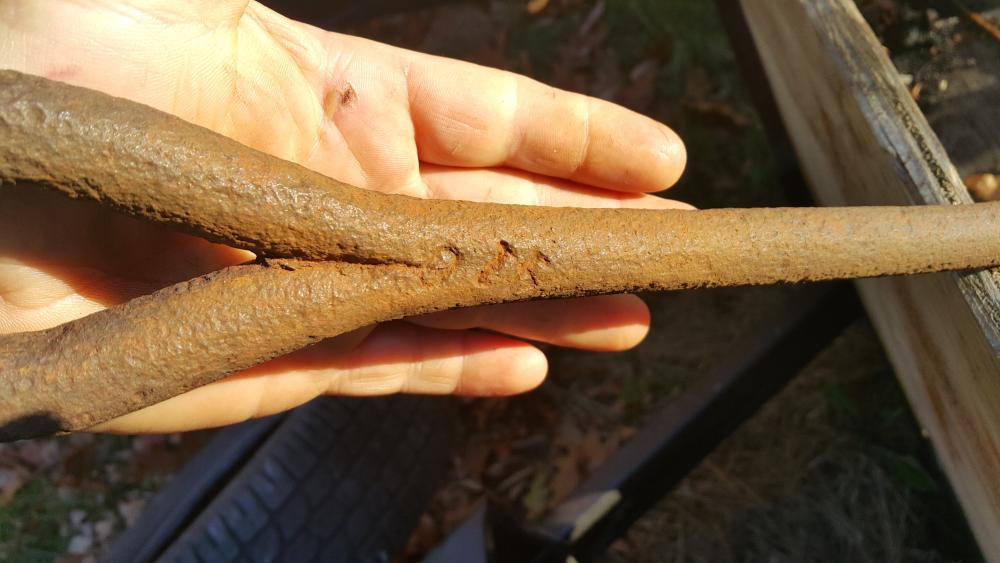
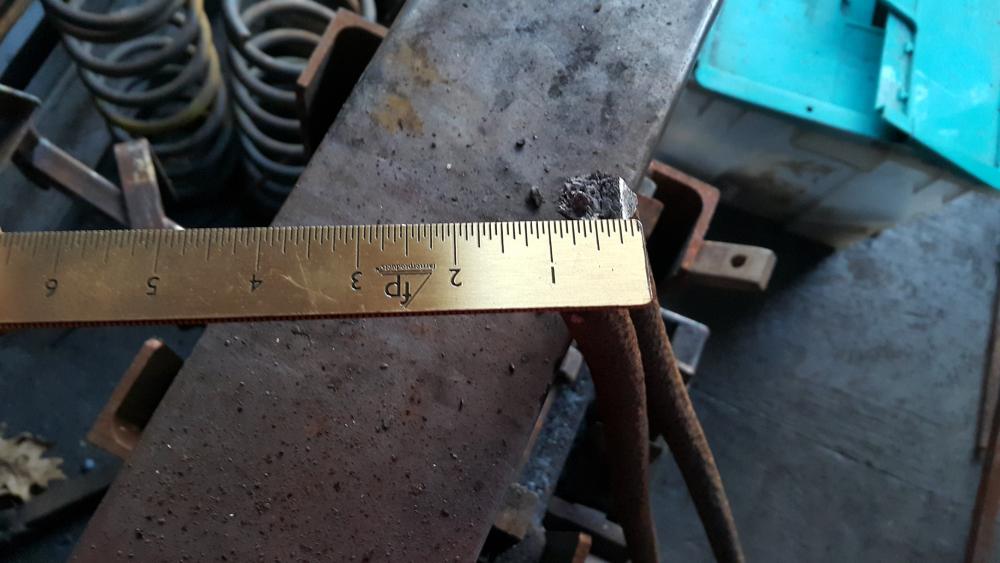
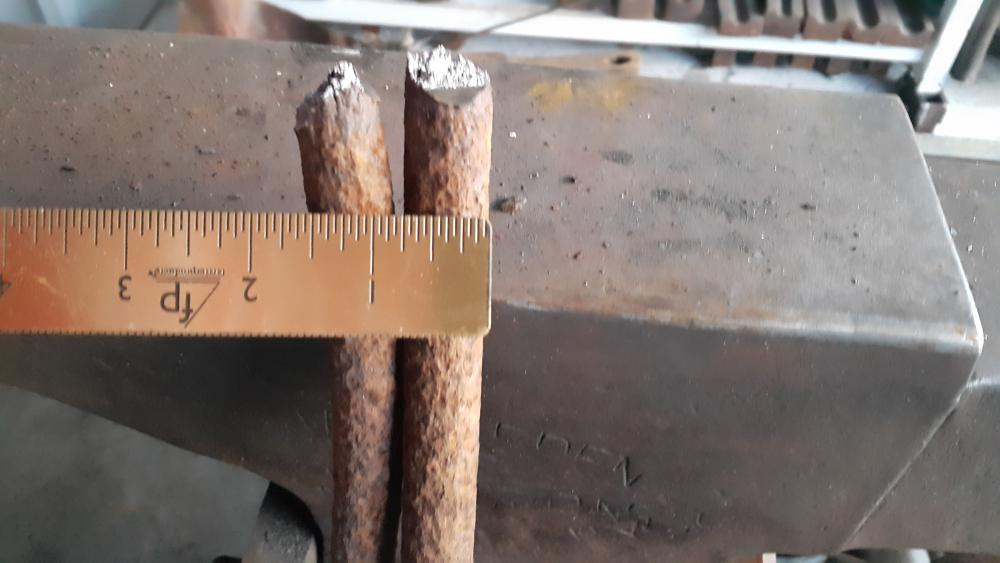
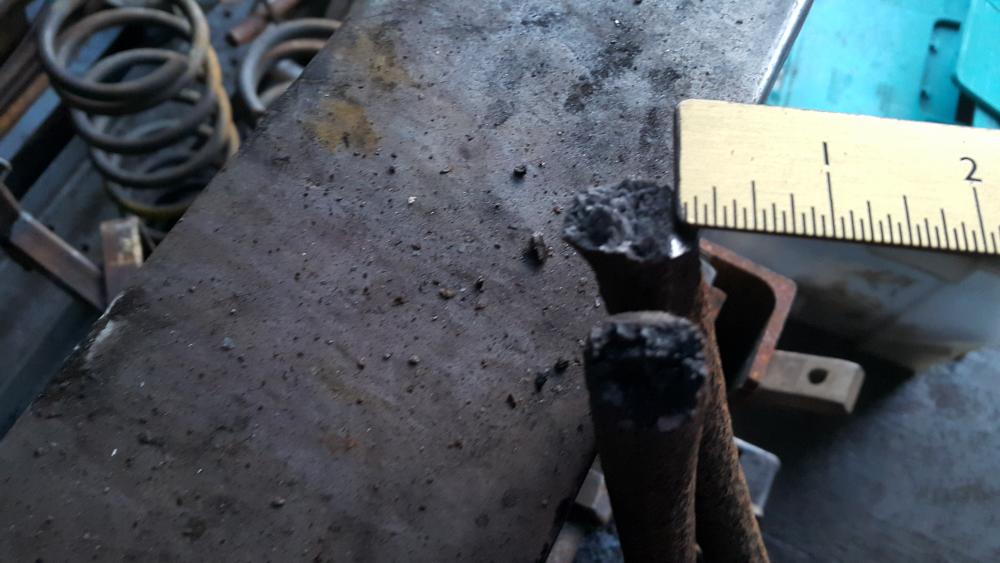
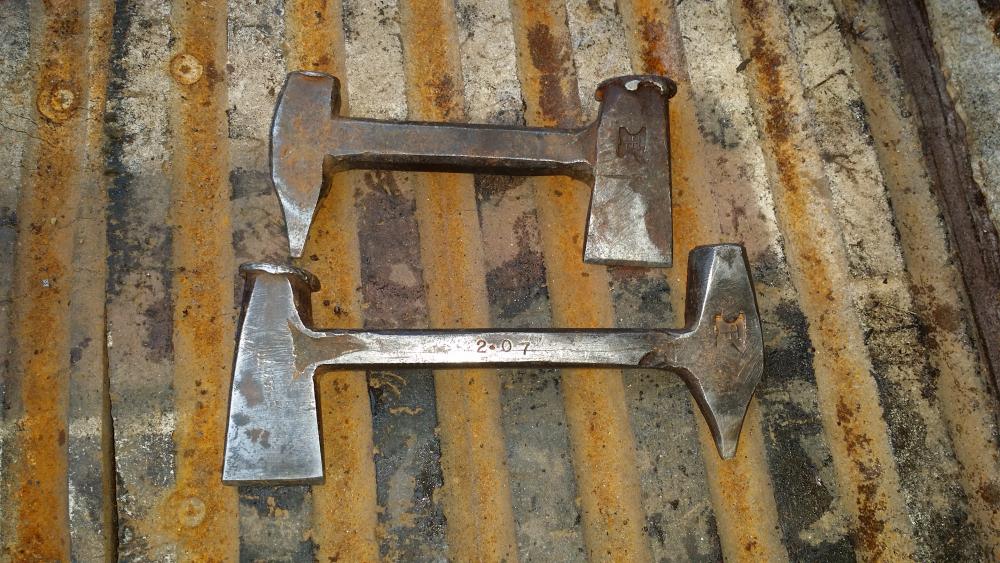
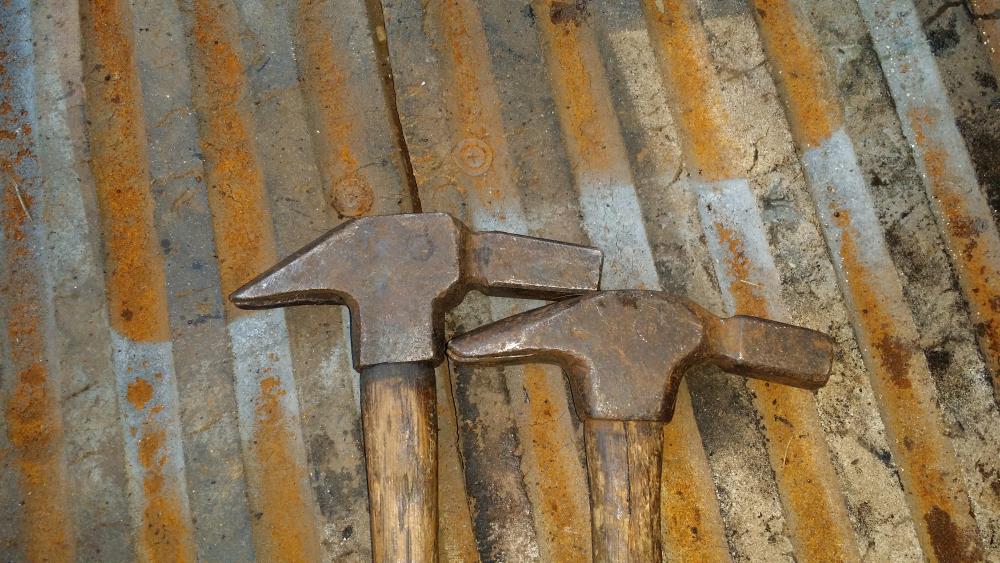
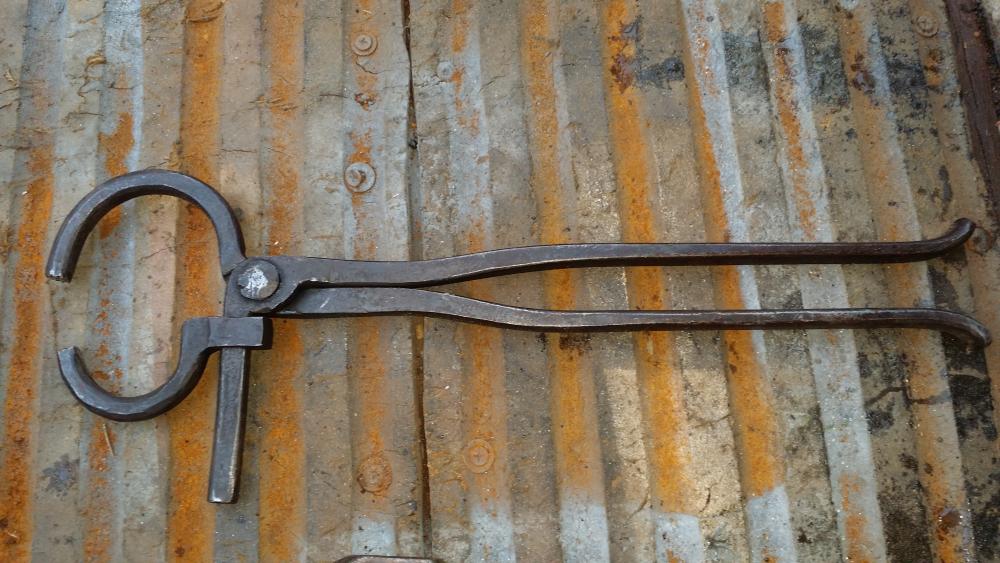
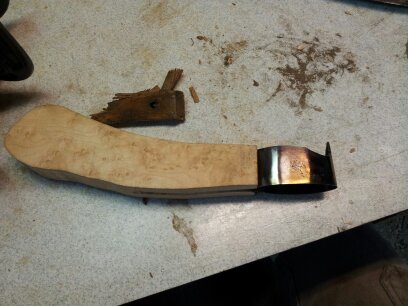
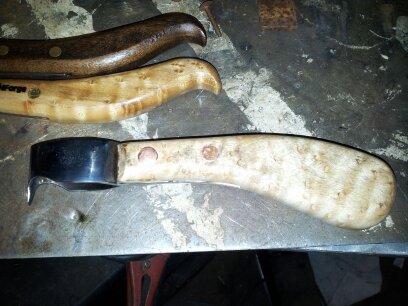
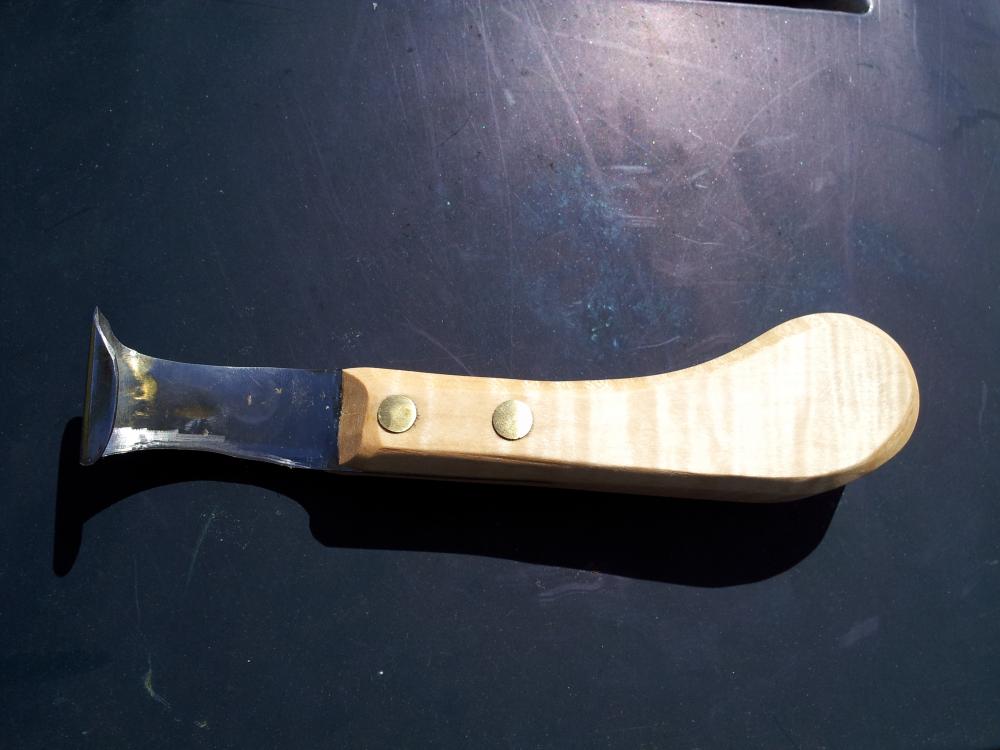
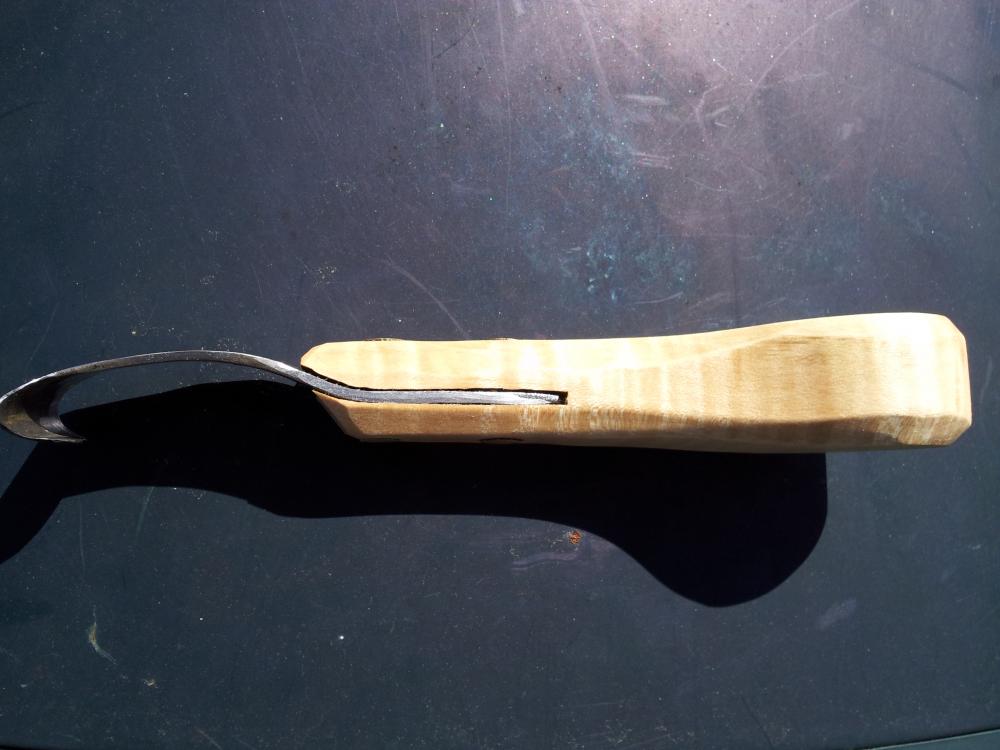
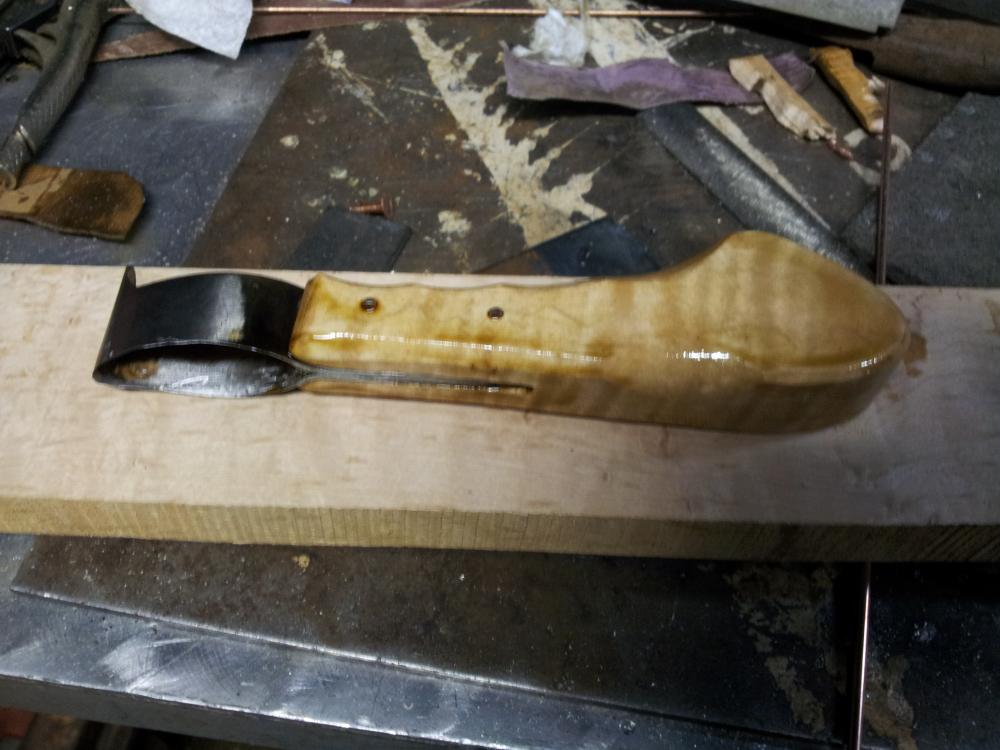
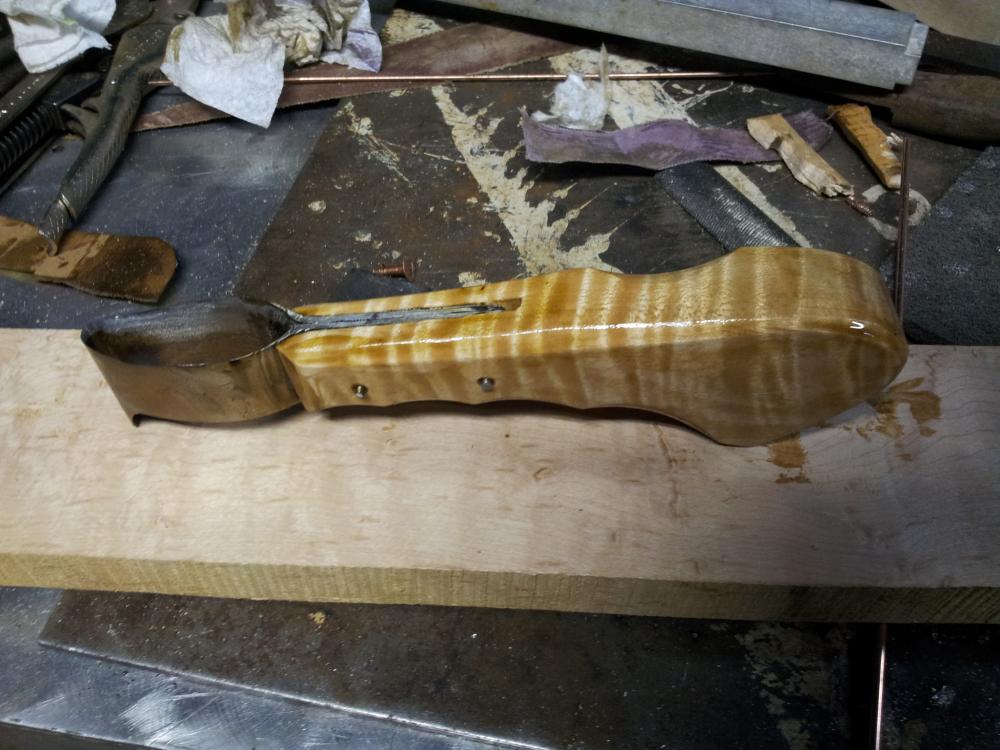
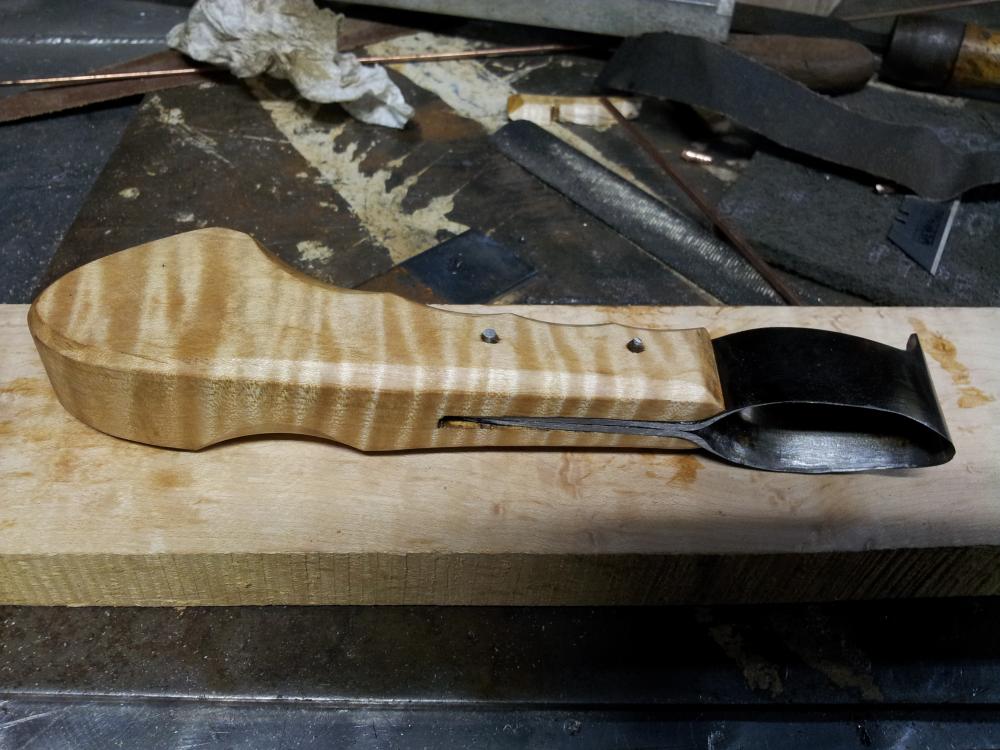
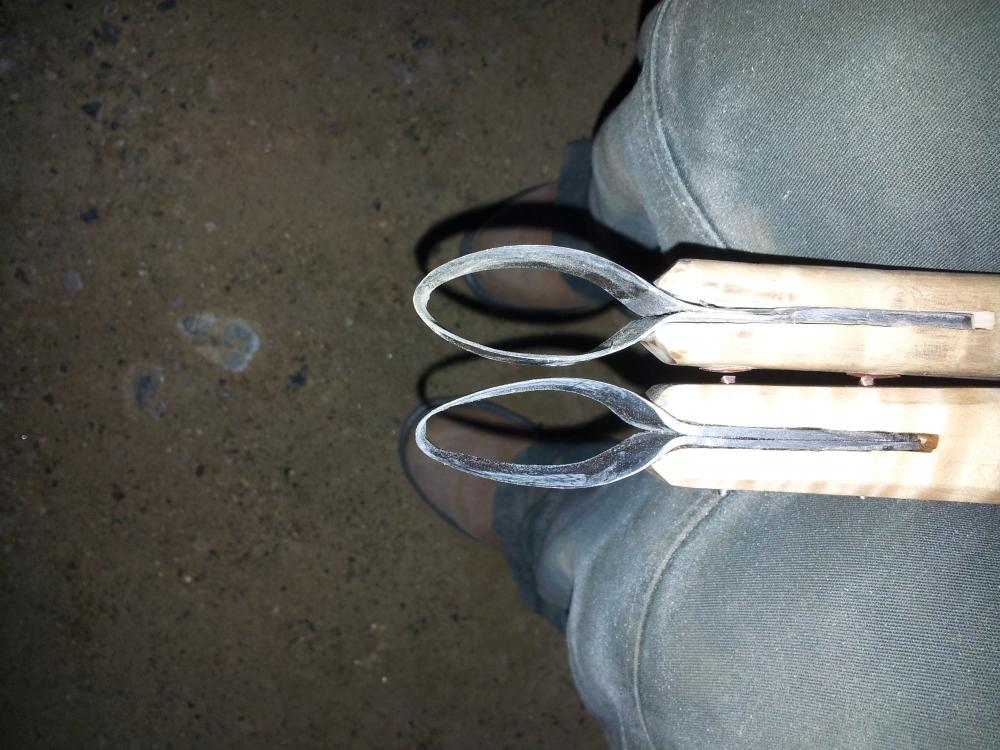
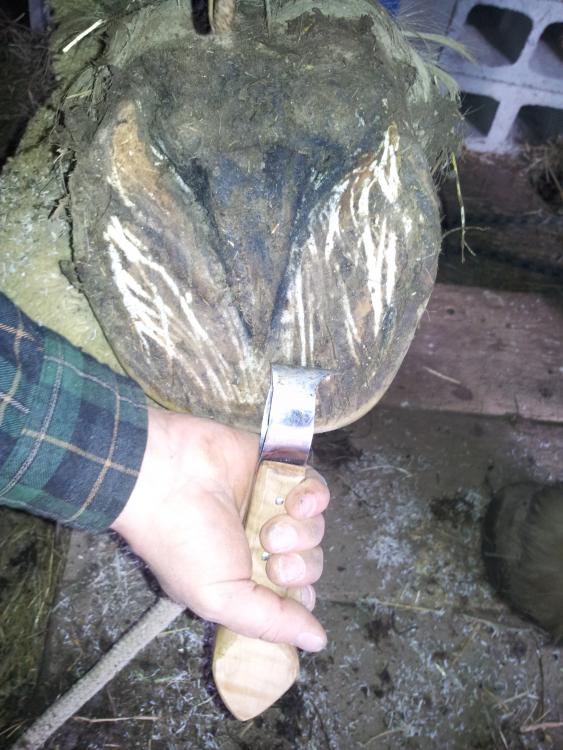
Damion78's diy vise design
in Vises
Posted
Okay, so the stress is the same if you want to get into equations. The force applied is the force applied and can be exponetially equated to difference loads, thicknesses.. etc, etc.. . What is not the same is the area in contact.. a tapered bolt offers more contact than a straight bolt.. Also for it to bind there would have to be no lubricant and forced in dramatically.. LOL.. fun right..
If you have to shim your vise.. The question becomes why? And how much of a shim in area are you actually putting in contact with the vise arm that is helping to eliminate the play you are associating with torquing when threading a bolt?
is it a big shim in area so offering more area to the vise jaw arm? The arm only has so much width or thickness.. Or is it a shim 13mm wide at each side of the bolt? Is there that much play because the vises bolt, or cheeks are worn or because it's rusted and the material is gone.. Each one of these pays into the next..
on any of the vises I have shown you. You wouldn't be able to fit even a 0.0001 shim into the joint unless there was something drastically wrong..Like a bent bolt or a completely egged out pivot hole, or a front jaw being bent downwards from abuse and then you would still need a egged out pivot hole..
Post some pictures of the vises worn surfaces and lets see exactly what the problem is.